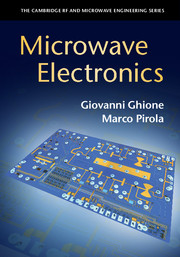Book contents
- Frontmatter
- Dedication
- Contents
- Preface
- Notation and Symbols
- 1 A System Introduction to Microwave Electronics
- 2 Passive Elements and Circuit Layout
- 3 CAD Techniques
- 4 Directional Couplers and Power Dividers
- 5 Active RF and Microwave Semiconductor Devices
- 6 Microwave Linear Amplifiers
- 7 Low-Noise Amplifier Design
- 8 Power Amplifiers
- 9 Microwave Measurements
- 10 CAD Projects
- Index
- References
8 - Power Amplifiers
Published online by Cambridge University Press: 10 November 2017
- Frontmatter
- Dedication
- Contents
- Preface
- Notation and Symbols
- 1 A System Introduction to Microwave Electronics
- 2 Passive Elements and Circuit Layout
- 3 CAD Techniques
- 4 Directional Couplers and Power Dividers
- 5 Active RF and Microwave Semiconductor Devices
- 6 Microwave Linear Amplifiers
- 7 Low-Noise Amplifier Design
- 8 Power Amplifiers
- 9 Microwave Measurements
- 10 CAD Projects
- Index
- References
Summary
Introduction
The purpose of RF and microwave power amplifiers [1, 2, 3] is to obtain, rather than the maximum power gain, the maximum output power compatible with a given device, with acceptable efficiency and linearity. The output power of active devices is, in fact, limited by the maximum voltage and current swing, in turn related to the drain or collector breakdown voltage and to the maximum current, respectively. Moreover, while in small-signal operation the device is approximately linear, power amplifiers, while being ultimately limited by output power saturation, exhibit nonlinear effects (i.e., distortion) that become increasingly important for large input power. Nonlinearities yield signal distortion due to the generation of harmonics and intermodulation products (IMPs); such a nonlinear distortion has to be kept under control to satisfy system requirements.
Power amplifiers are traditionally divided in classes. Class A (Sec. 8.4) amplifiers are quasi-linear since, at least ideally, the device output voltage and current swings corresponding to a single-tone sinusoidal inputs are again single-tone (neglecting distortion). In class B (Sec. 8.6.1) and C (Sec. 8.6.2) amplifiers (to confine ourselves to traditional amplifier classes) the output device current swing corresponding to a sinusoidal input is a set of sine pulses; this harmonic-rich, wideband waveform is converted on the load into a narrowband one through filtering (the so-called tuned load approach).1 The rationale behind introducing strongly nonlinear amplifiers is the increase of the amplifier efficiency, i.e., the ratio between the RF output power and the power from the DC supply (Sec. 8.2.4). Typically, there is a trade-off between efficiency and distortion; in class A amplifiers, low distortion can be achieved by reducing the input and output powers, at the expense of the amplifier efficiency. In traditional amplifier classes, high efficiency can be only achieved at the expense of a large gain penalty.
More advanced amplifier classes, like the harmonic loading amplifiers (class F, Sec. 8.7.1) or the switching amplifiers (e.g., class E, Sec. 8.7.2) are able to achieve a theoretical maximum 100 percent efficiency with acceptable gain. Other strategies (like the Doherty amplifier, Sec. 8.7.3) aim at providing an acceptable efficiency also when the input signal power is not constant, but covers wide dynamics, as needed in many real-life last-generation communication systems. A final issue concerns the efficiency– linearity trade-off.
- Type
- Chapter
- Information
- Microwave Electronics , pp. 411 - 488Publisher: Cambridge University PressPrint publication year: 2017



